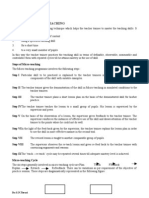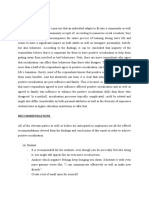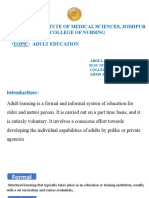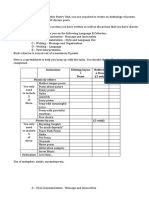Principles of Learning
Principles of Learning
Uploaded by
Hussin, FarahCopyright:
Available Formats
Principles of Learning
Principles of Learning
Uploaded by
Hussin, FarahOriginal Title
Copyright
Available Formats
Share this document
Did you find this document useful?
Is this content inappropriate?
Copyright:
Available Formats
Principles of Learning
Principles of Learning
Uploaded by
Hussin, FarahCopyright:
Available Formats
5 Principles of Learning
Learning principles are guidelines for the ways in which people learn most
effectively. The more these principles are reflected in training, the more
effective training is likely to be.
Research suggests that they apply equally to domestic and international
situations. These are the basic principles or conditions that facilitate learning.
Learning is a change in behavior as a result of experience. All living is learning.
Learning can be defined as a relatively permanent change in behavior
potentiality that results from reinforced practice or experience.
5 principles of learning are;
1. Participation.
2. Repetition.
3. Relevance.
4. Transference.
5. Feedback.
1. Participation
Learning should permit and encourage active participation of the learner.
Participation improves motivation and apparently engages more senses that
reinforce the learning process. As a result of participation, people learn more
quickly and retain that learning longer.
For example, most people never forget how to ride a bicycle because they
actively participated in the learning process.
The learning activities should be experiential rather than just informational.
Therefore, the trainers should arrange the physical surroundings to facilitate
small group interaction and promote the sharing of ideas.
2. Repetition
An important principle of the learning is to provide the learner with the
opportunity for practice and repetition. To gain the full benefit of training
learned behaviors must be overlearned to ensure smooth performance and
minimum of forgetting at a later date.
Proficiency in learning and retaining new skills is improved when individuals
visualize themselves performing the new behavior.
3. Relevance
Learning is helped when the material to be learned is meaningful. The learning
should be problem-centered rather than content centered.
The product life cycle is broken into four stages: introduction, growth, maturity, and
decline.
00:00/00:00
People are motivated to learn when training is immediately relevant to help
them solve a current problem. Learning something just because someone
says “it is important” is not as motivating.
4. Transference
Because the training occurs in a special environment, an important question
to ask is whether learning will transfer to the actual job situation.
Transfer of training occurs when trainees can apply the knowledge and skills
learned in training course to their jobs. If the learning in one setting does not
transfer to the actual job situation, the training has failed.
Three transfers training situations are possible
(1) Positive transfer of training when the training activities enhance
performance in the new situation;
(2) negative transfer of training, when the training activities inhibit
performance in a new situation; and
(3) no observable effect of training.
5. Feedback
Feedback gives learners information on their progress. Performance feedback
is a necessary prerequisite for learning. Feedback improves performance not
only by helping learners correct their mistakes but also by providing
reinforcement for learning.
Knowledge of results is a positive reinforcement itself. Learning activities
have more intrinsic interest if the feedback is available.
Nevertheless, performance feedback should do more than inform learners
whether they were right or wrong.
Merely informing the trainees that they were wrong is not as effective as
telling them why they were wrong and how they can avoid making mistakes in
the future. In general, knowledge of results is an essential feature of learning,
and this knowledge comes after the learner’s response.
You might also like
- Digital Marketing Strategy Development - Marketing MixDocument55 pagesDigital Marketing Strategy Development - Marketing MixMai Sang NguyễnNo ratings yet
- Course Title Course Code Number of UnitsDocument6 pagesCourse Title Course Code Number of UnitsMingNo ratings yet
- Puberty: Normal, Early, and Late DevelopmentDocument2 pagesPuberty: Normal, Early, and Late Developmentnisa_neyshaaljufri0% (1)
- Lecture MethodDocument7 pagesLecture MethodSrd Rch100% (1)
- Assessment RevDocument4 pagesAssessment RevJanine Anne De VeraNo ratings yet
- The Z ScoresDocument43 pagesThe Z ScoresLiezel DiazNo ratings yet
- Module 1 Educ 3Document29 pagesModule 1 Educ 3Selle Albero100% (1)
- Principles of AssessmentDocument3 pagesPrinciples of AssessmentDavid Rayner Sipilis MotiusNo ratings yet
- Seminar Method of LearningDocument14 pagesSeminar Method of LearningRAKESH KUMAR BAROI100% (1)
- Instructional DesignsDocument4 pagesInstructional DesignsDipti PunjalNo ratings yet
- Adult LearningDocument23 pagesAdult Learningprema100% (1)
- GROUP 9 TFN Hildegard PeplauDocument31 pagesGROUP 9 TFN Hildegard PeplauEla NavalesNo ratings yet
- Ida Jean Orlando: Deliberative Nursing Process TheoryDocument19 pagesIda Jean Orlando: Deliberative Nursing Process TheoryJames Andrew DalitNo ratings yet
- I Hear and I Forget. I See and I Remember. I Do and I Understand.Document14 pagesI Hear and I Forget. I See and I Remember. I Do and I Understand.Stephanie ClementNo ratings yet
- ConclusionDocument1 pageConclusionDelphy VargheseNo ratings yet
- Educational Philosophies Definition/Philosophers Implication/ApplicationDocument20 pagesEducational Philosophies Definition/Philosophers Implication/ApplicationLenz BautistaNo ratings yet
- Instructional AidsDocument5 pagesInstructional AidsPraba RajamanickamNo ratings yet
- Ge8-Ethics: Exercise 3: Case Study (Email Exposed)Document3 pagesGe8-Ethics: Exercise 3: Case Study (Email Exposed)Mary Rose Ponte FernandezNo ratings yet
- CURRICULUMDocument54 pagesCURRICULUMJoseph MusondaNo ratings yet
- Qualities of Good TestDocument32 pagesQualities of Good TestMuhammad Waseem Yasir RazaNo ratings yet
- The Comprehensive Compilation of LearningDocument3 pagesThe Comprehensive Compilation of LearningKim Arrianne CunananNo ratings yet
- Bloom's Taxonomy CognitiveDocument4 pagesBloom's Taxonomy CognitiveNawalNo ratings yet
- Principles of LearningDocument4 pagesPrinciples of LearningLavinia FernandezNo ratings yet
- The Filipino Moral DevelopmentDocument11 pagesThe Filipino Moral DevelopmentEli Saeyori100% (1)
- Interactive RadioDocument9 pagesInteractive RadioYashwant Singh RathoreNo ratings yet
- Maternal Role Attainment Theory IDocument7 pagesMaternal Role Attainment Theory IswethashakiNo ratings yet
- Panel DiscussionDocument2 pagesPanel DiscussionReden Basag IlokNo ratings yet
- Concept of Micro-Teaching: Dr.G.N.TiwariDocument7 pagesConcept of Micro-Teaching: Dr.G.N.TiwariGyanendra TiwariNo ratings yet
- Formative and Summative AssessmentDocument2 pagesFormative and Summative AssessmentsupositionNo ratings yet
- Reaction PaperDocument3 pagesReaction Paperedmond callenNo ratings yet
- Problem-Based Learning Jocelyn.Document19 pagesProblem-Based Learning Jocelyn.Jocelyn MirandaNo ratings yet
- Unit-V Principles of Teaching and Learning ProcessDocument72 pagesUnit-V Principles of Teaching and Learning Processnidhisha pillaiNo ratings yet
- Learning Theories and Styles: Lesson 4Document20 pagesLearning Theories and Styles: Lesson 4Vernadel ApolloNo ratings yet
- The Moral Aspect of PersonalityDocument2 pagesThe Moral Aspect of PersonalityAaron Roxas40% (5)
- Behaviorism TheoryDocument10 pagesBehaviorism TheoryJelyn MendozaNo ratings yet
- The Process of Prenatal Development Occurs in Three Main StagesDocument2 pagesThe Process of Prenatal Development Occurs in Three Main StagesMuhammad HassanNo ratings yet
- The Communication ProcessDocument3 pagesThe Communication ProcessJane QuintosNo ratings yet
- Hallmarks of Effective TeachingDocument48 pagesHallmarks of Effective TeachingA Dummy's Angle100% (1)
- Background:: Nursing Process TheoryDocument5 pagesBackground:: Nursing Process TheorySofia Marie GalendezNo ratings yet
- Freuds Phychosexual Theory - 080804Document11 pagesFreuds Phychosexual Theory - 080804walter100% (1)
- Learning Strategies and Learner CharacteristicsDocument3 pagesLearning Strategies and Learner CharacteristicsresearchparksNo ratings yet
- Understanding The Self Psych 1A: Name: Marinette R. Parra Year & Section: - BSE-FILIPINO 1-2Document4 pagesUnderstanding The Self Psych 1A: Name: Marinette R. Parra Year & Section: - BSE-FILIPINO 1-2Marinette Parra100% (1)
- CMO 14 PowerpointDocument48 pagesCMO 14 PowerpointNethera Kiza Imperial100% (1)
- Conclusion & Recommendations Ewc661Document2 pagesConclusion & Recommendations Ewc661Ruzana MokhtarNo ratings yet
- 1.5 WorkshopDocument25 pages1.5 WorkshopSweety YadavNo ratings yet
- Ne - (Adult Education0Document31 pagesNe - (Adult Education0Hemant100% (1)
- MODULE 5 - Gestalt TheoryDocument14 pagesMODULE 5 - Gestalt TheoryDarlyn Ann VillanuevaNo ratings yet
- A Study To Assess The Effectiveness of Self Instructional Module Regarding Dyslexia and Davis Dyslexia Correction Method Among Primary School Teachers in Selected Schools at Bangalore, Karnataka.Document5 pagesA Study To Assess The Effectiveness of Self Instructional Module Regarding Dyslexia and Davis Dyslexia Correction Method Among Primary School Teachers in Selected Schools at Bangalore, Karnataka.International Journal of Innovative Science and Research TechnologyNo ratings yet
- Common Illnesses and Injuries: Study Guide For Module No. 5Document12 pagesCommon Illnesses and Injuries: Study Guide For Module No. 5Fiona LozanoNo ratings yet
- A Traditional Curriculum Typically Involves A Teacher Conveying Facts To Students. The Curriculum FocusesDocument4 pagesA Traditional Curriculum Typically Involves A Teacher Conveying Facts To Students. The Curriculum FocusesJOHN CARMELO SAULONNo ratings yet
- Developmental Stages and Tasks Doc 1Document6 pagesDevelopmental Stages and Tasks Doc 1loraine cloresNo ratings yet
- Abdellah Theory 2021-22Document33 pagesAbdellah Theory 2021-22M ANo ratings yet
- The Adult LearningDocument15 pagesThe Adult LearningBryan Mae H. DegorioNo ratings yet
- Thinking ProcessDocument4 pagesThinking ProcessAndalNo ratings yet
- Philippine HistoryDocument5 pagesPhilippine HistoryRhona Villamater BronzalNo ratings yet
- Behavioral Objectives and Teaching Plans: Laicherry Y. RomanDocument52 pagesBehavioral Objectives and Teaching Plans: Laicherry Y. RomanJohnRowenPerjeDianaNo ratings yet
- Objective ModelDocument5 pagesObjective ModelAyesha AhmedNo ratings yet
- Peplau's Interpersonal Relations Theory Power PointDocument12 pagesPeplau's Interpersonal Relations Theory Power Pointrossaniza RamlanNo ratings yet
- TFN Report SummaryDocument3 pagesTFN Report SummaryA CNo ratings yet
- Cultural PerspectivesDocument29 pagesCultural PerspectivesMichelle Taton HoranNo ratings yet
- Glimpse of UsDocument4 pagesGlimpse of UsHussin, FarahNo ratings yet
- Sample QDocument4 pagesSample QHussin, FarahNo ratings yet
- RRLDocument4 pagesRRLHussin, FarahNo ratings yet
- Sample QuestionnaireDocument4 pagesSample QuestionnaireHussin, FarahNo ratings yet
- EnterococcusDocument2 pagesEnterococcusHussin, FarahNo ratings yet
- Plans Communication ManagementDocument8 pagesPlans Communication Managementarshad zaheer100% (1)
- Your Anthology ChecklistDocument2 pagesYour Anthology ChecklistIntrepidteacherNo ratings yet
- Engl111 Reviewer MidtermDocument8 pagesEngl111 Reviewer MidtermJessa Vel FloresNo ratings yet
- Unit 4 Basic TestDocument2 pagesUnit 4 Basic TestCarla MartinoNo ratings yet
- Business - Result - Intermediate - Teacher - 39 - S - Book (1) - 17Document1 pageBusiness - Result - Intermediate - Teacher - 39 - S - Book (1) - 17Ermal SinanajNo ratings yet
- FOR Finding Our Roots Erasmus+ ProjectDocument9 pagesFOR Finding Our Roots Erasmus+ ProjectKARMELENo ratings yet
- Effects of Auto-Correction On Students' Writing Skill at Three Different Universities in Sulaimaneyah City Kozhin Omer IsmaelDocument15 pagesEffects of Auto-Correction On Students' Writing Skill at Three Different Universities in Sulaimaneyah City Kozhin Omer IsmaelnvbnvbnvNo ratings yet
- Coaching PlanDocument6 pagesCoaching Planarlene cristinoNo ratings yet
- Lecture 7 Australian EnglishesDocument26 pagesLecture 7 Australian Englishesjeni evalitaNo ratings yet
- Milestone02 Luqman Alagbe 29.10.2023Document6 pagesMilestone02 Luqman Alagbe 29.10.2023farsalNo ratings yet
- 4 Planificacion Microcurricular I I Quimester ElementalDocument7 pages4 Planificacion Microcurricular I I Quimester ElementalMaria NarvaezNo ratings yet
- DLL Mathematics-3 Q3Document4 pagesDLL Mathematics-3 Q3Blessed GuillermoNo ratings yet
- Keynote UPPER STUDENT BookDocument10 pagesKeynote UPPER STUDENT BookRenata Gazola100% (1)
- Learming Skills 3 Midterm Module IDocument5 pagesLearming Skills 3 Midterm Module IericajanesarayanNo ratings yet
- Cambridge IGCSE ™: English As A Second Language 0510/21Document10 pagesCambridge IGCSE ™: English As A Second Language 0510/21界洋美語No ratings yet
- 3 - The Origins and Evolution of Language - Michael Corballis (TedxAuckland)Document3 pages3 - The Origins and Evolution of Language - Michael Corballis (TedxAuckland)cosme.fulanitaNo ratings yet
- English2 - q1 - CLAS2 - English - Alphabet - RHEA ANN NAVILLADocument11 pagesEnglish2 - q1 - CLAS2 - English - Alphabet - RHEA ANN NAVILLAMARIA ELENA IRENE FERNANDEZNo ratings yet
- Phase1 Action Plan Education MAM Mariet EditedDocument17 pagesPhase1 Action Plan Education MAM Mariet EditedEdgardo PadinNo ratings yet
- MPU22012 PRODUCT PITCHING BERTANDATANGAN KProDocument8 pagesMPU22012 PRODUCT PITCHING BERTANDATANGAN KPromuhdfaishal05No ratings yet
- RPH Online TemplateDocument8 pagesRPH Online TemplateAnonymous gql49rNo ratings yet
- Lesson Plan What Is Her Job 4thDocument3 pagesLesson Plan What Is Her Job 4thviorelcruduNo ratings yet
- Y9 Criterion D, All PhasesDocument11 pagesY9 Criterion D, All PhasesEliseNo ratings yet
- IB-DP Grade 11 English A Literature HL Paper 1 (MS)Document3 pagesIB-DP Grade 11 English A Literature HL Paper 1 (MS)M MNo ratings yet
- 1.280 ATP 2023-24 GR 5 English HL FinalDocument22 pages1.280 ATP 2023-24 GR 5 English HL Finalnehelomokadi127No ratings yet
- Communicating at WorkDocument17 pagesCommunicating at WorkJulia El SamraNo ratings yet
- Conceptualizing Empathy Competence: A Professional Communication PerspectiveDocument36 pagesConceptualizing Empathy Competence: A Professional Communication PerspectivePhoenix AngelliaNo ratings yet
- Literacy UnitsDocument69 pagesLiteracy UnitsBRITTANY WALLNERNo ratings yet
- Personal Narrative - Peer Editing Checklist: Step 1Document2 pagesPersonal Narrative - Peer Editing Checklist: Step 1Patrick MilumNo ratings yet
- RFP Process - Roles and ResponsibilitiesDocument17 pagesRFP Process - Roles and ResponsibilitiescceisniperNo ratings yet






























































































